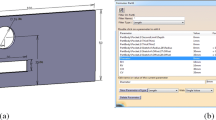Abstract
The improvement of the simulation process requires an integration of the design and analysis models. There are two essential tasks in the design analysis process: (i) computer-aided design (CAD) which provides the geometric description of the model and (ii) the finite element method (FEM) used for mechanical behaviour simulations. The interoperability between these two tasks reduces costs and improves product quality through the acceleration of design analysis loops. Our activity fits into this research orientation by providing a method to link the FE analysis and the CAD model. This is done by reconstructing the CAD model from the FE analysis results (deformed mesh). This paper proposes a method to update the CAD geometry from the deformed mesh. This approach allows for rebuilding the CAD model after analysis by extracting geometric information from the deformed mesh. An illustration of the developed method is discussed at the end of this paper.
Similar content being viewed by others
References
Louhichi B, Aifaoui N, Hamdi M, BenAmara A, Francois V (2009) An optimization-based computational method for surface fitting to update the geometric information of an existing B-Rep CAD model. Int J CAD/CAM 9(1):17–24
Foucault G, Cuillière JC, Francois V, Léon JC, Maranzana R (2008) Adaptation of CAD model topology for finite element analysis. Comput Aided Des 40(2):176–196
Béchet E, Cuillière JC, Trochu F (2002) Generation of a finite element mesh from stereolithography (STL) files. Comput Aided Des 34:1–17
Wall WA, Frenzel MA, Cyron C (2008) Isogeometric structural shape optimization. Comput Methods Appl Mech Engrg 197:2976–2988
Rypl D, Patzák B (2013) Construction of weighted dual graphs of NURBS-based isogeometric meshes. Adv Eng Softw 60–61:31–41
Bloor MIG, Wilson MJ (1990) Representing PDE surfaces in terms of B-splines. Comput Aided Des 22(6):324–331
Qin J, Terzopoulos D (1996) D-NURBS: a physics-based framework for geometric design. IEEE Trans Vis Comput Graph 2(1):85–96
La Areca R, Daniel M (2004) Declarative approach to NURBS surface design: from semantic to geometric models. International Conference on Computer Graphics and Artificial Intelligence, conference proceedings: p 161–168
Song X, Jüttler B (2009) Modeling and 3D object reconstruction by implicitly defined surfaces with sharp features. Comput Graph 33:321–330
Xiea W-C, Zoua X-F, Yangb J-D, Yangb J-B (2012) Iteration and optimization scheme for the reconstruction of 3D surfaces based on non-uniform rational B-splines. Comput Aided Des 44:1127–1140
Lee ETY (1989) Choosing nodes in parametric curve interpolation. Comput Aided Des 21(6):363–370
Piegel L, Tiller W (1997) The NURBS book. Springer, New York
Author information
Authors and Affiliations
Corresponding author
Rights and permissions
About this article
Cite this article
Louhichi, B., Abenhaim, G.N. & Tahan, A.S. CAD/CAE integration: updating the CAD model after a FEM analysis. Int J Adv Manuf Technol 76, 391–400 (2015). https://doi.org/10.1007/s00170-014-6248-y
Received:
Accepted:
Published:
Issue Date:
DOI: https://doi.org/10.1007/s00170-014-6248-y




